Related Research Articles

The Florida East Coast Railway is a Class II railroad operating in the U.S. state of Florida, currently owned by Grupo México.
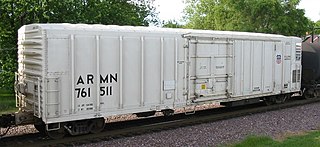
A refrigerator car is a refrigerated boxcar (U.S.), a piece of railroad rolling stock designed to carry perishable freight at specific temperatures. Refrigerator cars differ from simple insulated boxcars and ventilated boxcars, neither of which are fitted with cooling apparatus. Reefers can be ice-cooled, come equipped with any one of a variety of mechanical refrigeration systems, or utilize carbon dioxide as a cooling agent. Milk cars may or may not include a cooling system, but are equipped with high-speed trucks and other modifications that allow them to travel with passenger trains.

An autorack, also known as an auto carrier, is a specialized piece of railroad rolling stock used to transport automobiles and light trucks. Autoracks are used to transport new vehicles from factories to automotive distributors, and to transport passengers' vehicles in car shuttles and motorail services, such as Amtrak's Auto Train route.

The Grand Trunk Western Railroad Company was an American subsidiary of the Grand Trunk Railway, later of the Canadian National Railway operating in Michigan, Illinois, Indiana, and Ohio. Since a corporate restructuring in 1971, the railroad has been under CN's subsidiary holding company, the Grand Trunk Corporation. Grand Trunk Western's routes are part of CN's Michigan Division. Its primary mainline between Chicago and Port Huron, Michigan serves as a connection between railroad interchanges in Chicago and rail lines in eastern Canada and the Northeastern United States. The railroad's extensive trackage in Detroit and across southern Michigan has made it an essential link for the automotive industry as a hauler of parts and automobiles from manufacturing plants.

South Central Florida Express, Inc. is a common carrier shortline railroad in southern Florida run by U.S. Sugar Corporation. Its trains operate from Sebring to Fort Pierce via Clewiston around the southern perimeter of Lake Okeechobee, and serves customers at 26 locations. With 171 miles (275 km) of track, the SCXF is the largest private agricultural railroad in the U.S.
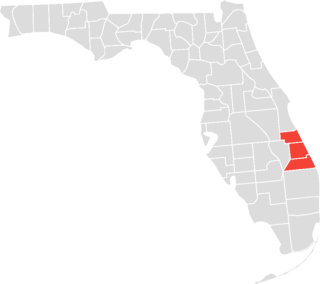
The Treasure Coast is a region in the southeast of the U.S. state of Florida. It borders the Atlantic Ocean and comprises Indian River, Martin, and St. Lucie counties. The region, whose name refers to the Spanish Treasure Fleet that was lost in a 1715 hurricane, evidently emerged from residents' desire to distinguish themselves from the Gold Coast to the south.
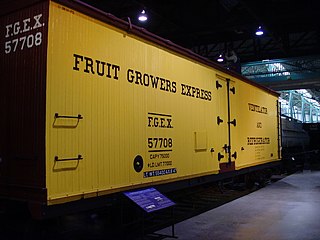
Fruit Growers Express (FGE) was a railroad refrigerator car leasing company that began as a produce-hauling subsidiary of Armour and Company's private refrigerator car line. Armour controlled both the packing operations and the transport insulated railroad car line, and its customers had complained they were overcharged. In 1919 the Federal Trade Commission ordered the company's spinoff of Fruit Growers Express for antitrust reasons, which was accomplished by 1920.
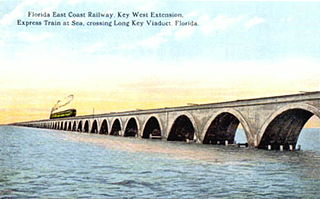
The Overseas Railroad was an extension of the Florida East Coast Railway to Key West, a city located 128 miles (206 km) beyond the end of the Florida peninsula. Work on the line started in 1905 and it operated from 1912 to 1935, when it was partially destroyed by the Labor Day Hurricane. Some of the remaining infrastructure was used for the Overseas Highway.

The Grand Trunk Milwaukee Car Ferry Company was the Grand Trunk Western Railroad's subsidiary company operating its Lake Michigan railroad car ferry operations between Muskegon, Michigan, and Milwaukee, Wisconsin, from 1905 to 1978. Major railroad companies in Michigan used rail ferry vessels to transport rail cars across Lake Michigan from Michigan's western shore to eastern Wisconsin to avoid rail traffic congestion in Chicago.

Seatrain Lines, officially the Over-Seas Shipping Company, was a shipping and transportation company conducting operations in the Americas and trans-Pacific regions. Seatrain Lines began intermodal freight transport in December 1928 by transporting entire loaded railroad freight cars between the United States and Cuba. The specially designed ship Seatrain, built in England, was followed in 1932 by two larger ships built in the United States and in 1939 by two additional ships. By the outbreak of World War II the company was operating five ships that became important in the war effort and basis for the design of fifty new ships for military use. A series of business setbacks amid the rise of containerized shipping left the company in perilous financial condition in the 1970s. Seatrain Lines shut down in 1981 after filing for bankruptcy.

The Champion was a streamlined passenger train operated by the Atlantic Coast Line Railroad and Florida East Coast Railway between New York City and Miami or St. Petersburg, Florida. It operated from 1939 until 1979, continuing under the Seaboard Coast Line and Amtrak. It was a direct competitor to the Seaboard Air Line Railway's Silver Meteor, the first New York-Florida streamliner.
The South Wind was a named passenger train equipped and operated jointly by the Pennsylvania Railroad, the Louisville and Nashville Railroad, the Atlantic Coast Line Railroad, and the Florida East Coast Railway. The South Wind began operations in December 1940, providing streamliner service between Chicago, Illinois and Miami, Florida. This was one of three new seven-car, all-coach streamliners operating in coordination every third day along different routes between Chicago and Miami. The other two longest enduring Chicago-Florida trains were the City of Miami and the Dixie Flagler. The South Wind remained in service through the creation of Amtrak in 1971.
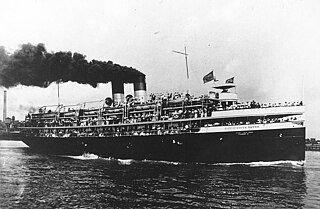
USS City of South Haven (ID-2527) was a transport ship for the United States Navy at the close of World War I. Before the war, she was a passenger steamship that sailed as SS City of South Haven on the Great Lakes. In post-war civilian service she operated as SS City of Miami between Florida and Cuba before returning to the Great Lakes as SS E.G. Crosby. She was scrapped in 1942 following a fire.

SS Yorktown was launched February 10, 1894, by Delaware River Iron Ship Building and Engine Works, Chester, Pennsylvania for the Old Dominion Steamship Company for the company's overnight New York City/Norfolk, Virginia service. The United States Navy purchased Yorktown on April 21, 1898, to be commissioned as the second USS Resolute, an auxiliary cruiser and transport that saw naval service during the Spanish–American War 1898–1899. The United States Department of War acquired the ship on January 22, 1900, for service as the United States Army Transport (USAT) Rawlins. The ship was sold to the Merchants and Miners Transportation Company of Baltimore, Maryland on July 27, 1901, and renamed Powhatan. Powhatan was wrecked in 1916 and in 1919 rebuilt as the world's first turbo-electric propelled passenger ship Cuba for luxury passenger and express freight service between Florida and Cuba with the Miami Steamship Company beginning service in 1920. Renamed Seneca, the ship burned and sank December 30, 1927, at Hoboken, New Jersey then refloated September 2, 1928, and scrapped.

The Dixie Flagler was a streamlined passenger train operated by the Florida East Coast Railway (FEC) between Chicago, Illinois and Miami, Florida. It began in 1939 as the Henry M. Flagler, a regional service between Miami and Jacksonville, Florida; the FEC renamed it and extended it to Chicago a year later. It was one of the few Chicago to Florida trains that passed through Atlanta. As an overnight streamliner it was part of the every-third-day pool shared by the City of Miami and South Wind. It was renamed Dixieland in 1954 and discontinued altogether in 1957.

MV Patrick Morris was a Canadian National Railway (CN) train ferry that sank on her run from North Sydney, Nova Scotia to Port aux Basques, Newfoundland during a storm in the early morning hours of 20 April 1970 while responding to a mayday call from the Newfoundland-based herring seiner FV Enterprise. The ship's Captain Roland Penney was given permission to leave North Sydney ahead of schedule to assist the wood-hulled fishing vessel in distress. No passengers were aboard Patrick Morris when she set sail shortly before midnight for the rescue mission on 19 April.

USAT Cuba was the passenger ship Cuba of the Peninsular & Occidental Steamship Company built by William Cramp & Sons Shipbuilding Company, Philadelphia in 1920 and placed into operation in 1921 for scheduled passenger and freight service between Tampa, Key West and Havana.

Agwilines Inc was a passenger and cargo shipping company of New York City. Agwilines is short for Atlantic, Gulf & West Indies Steamship Inc. AGWI Lines group operated four main lines in the 1910s, 1920s and 1930s:
References
- ↑ "WEST INDIA LISTS FERRIES FOR SALE; Six Rail Car-Auto Vessels Served U.S.-Cuba Trade". New York Times. June 2, 1961. Retrieved 2008-01-06.
- ↑ "Boxcar Modeling The West India Fruit Car", Mainline Modeler, May 1988.
- 1 2 Superior All-Rail-Route to Cuba [brochure], West India Fruit and Steamship
- 1 2 Hilton, George W. (2003) [1962], The Great Lakes Car Ferries, Davenport, Iowa: Montevallo Historical Press, ISBN 0-9658624-3-7
- 1 2 3 4 5 6 Mueller, Edward A. (1996), Steamships of the Two Henrys
- 1 2 Krieger, Michael (1998), Where Rails Meet the Sea , New York, NY: MetroBooks, ISBN 1-56799-597-7
- ↑ Drive Your Car to Cuba [brochure], West India Fruit and Steamship, Nov 1956
- ↑ Ridolph, Edward A, Edward A (1979), "The Boat Trains: Havana Car Ferry", National Railway Bulletin, 44 (2).
- 1 2 3 "Cars Go Overnight to Cuba", Railway Age, April 7, 1952.
- 1 2 Zanetti, Oscar; Garcia, Alejandro (1998), Sugar and Railroads: A Cuban History, 1837-1959 (English Translation), Chapel Hill: The University of North Carolina Press, ISBN 0-8078-4692-9
- ↑ The Official Guide, West India Fruit and Steamship Co., Inc., Nov 1957
- ↑ Middleton, William D. (2003), The Last Interurbans, Chicago, Ill.: Central Electric Railfans' Association, ISBN 0-915348-36-5
- ↑ Bramson, Seth H. (2003) [1984], Speedway to Sunshine: The Story of the Florida East Coast Railway, Erin, ON: Boston Mills Press, ISBN 1-55046-358-6